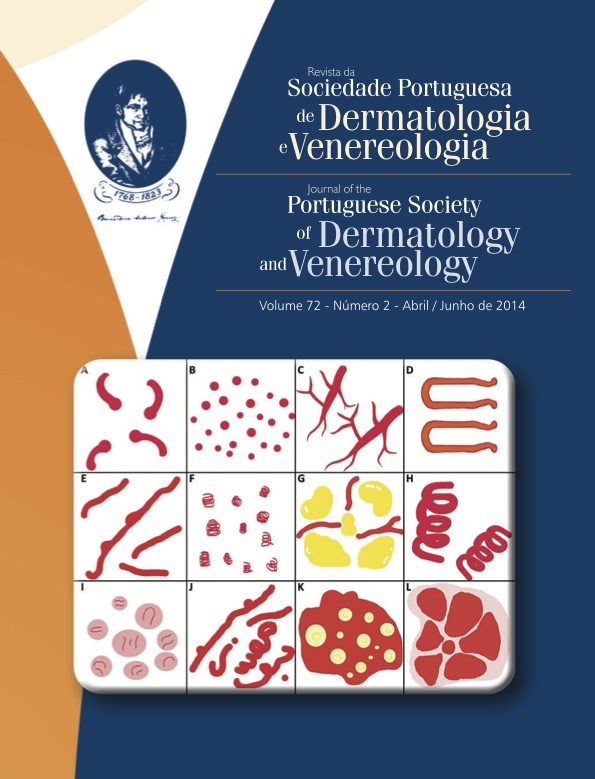PARAGANGLIOMA AND ANGIOEDEMA
Abstract
Paragangliomas or extra-adrenal pheochromocytomas are rare tumors that arise from chromaffin tissues and tend to occur either sporadically or in the context of complex genetic disorders. They are clinically heterogeneous in nature - symptoms deriving either from the secretory profile of the tumor or from the mass effect of the neoplasm. Dermatologic symptoms are quite seldom described in the literature and have been classified in acute or chronic. The case of a 40 YO Caucasian female that had been enduring for the last 2 years recurring self-limited episodes of angioedema, diarrhoea, chest pain, hypertension or hypotension, dyspnoea and anxiety is reported. Biochemical studies and further imagiologic work up and, later on, pathologic exam allowed to identify a paraganglioma that drained to the left renal artery. Upon surgery, during tumor manipulation, the patient developed an additional systemic crisis that required active life support. Recovery was regular, with a quick and sustained normalization of lab results as well as on the clinical side, with no further episode for the last 17 years.
Downloads
References
Lenders JW, Eisenhofer G, Mannelli M, Pacak K. Pheochromocytoma. Lancet. 2005; 366 (9486):665-75.
Pacak K, Linehan WM, Eisenhofer G, et al. Recente advances in genetics, diagnosis, localization, and treatment of pheochromocytoma. Ann Intern Med. 2001; 134:315-29.
Sinclair AM, Islas CG, Brown J, et al. Secondary hypertension in a blood pressure clinic. Arch Intern Med. 1987; 147:1289-93.
Omura M, Saito J, Yamagushi K, et al. Prospective study on the prevalence of secondary hypertension
among hypertensive patients visiting a general outpatient clinic in Japan. Hypertens Res. 2004; 27:193-202.
Neumman HP, Beger DP, Sigmund G, et al. Pheochromocytomas, multiple endocrine neoplasia type 2, and von Hippel-Lindau disease. N Engl J Med. 1993; 329:1531-8.
Maher ER, Eng C. The pressure rises: update on the genetics of pheochromocytoma. Hum Mol Genet. 2002; 11:2347-54.
Bravo EL, Tagle R. Pheochromocytoma: state-of--the-art and future prospects. Endocr Rev. 2003; 24:539-53.
Kebebew E, Duh QY. Benign and malignant pheochromocytoma: diagnosis, treatment, and follow-up. Surg Oncol Clin N Am. 1998; 7:765-89.
Batide-Alanore A, Chatellier G, Plonin PF. Diabetes as a marker of pheochromocytoma in hypertensive patients. J Hypertens. 2003; 21:1703-7.
Viveros OH, Wilson SP. The adrenal chromatin cell as a model to study the co-secretion of enkephalins and catecholamines. J Auton Nerv System. 1983; 7:41-58.
Dany F, Doutre MS, Copillaud G, et al. Manifestations cutanées du phéochromocytome. A propos d`une observation. Sem Hôp Paris. 1981; 57:25-7, 1223-5.
Blanchet P. Les manifestations Vaso-Motrices Cutanées Paroxystiques. Ann Dermatol Venereol. 1978; 105:1001-7.
Feingold KR, Elias PM. Endocrine-skin interactions. J Am Acad Dermatol. 1988; 19:1-20.
Di Matteo J, Cachera JP, Henlin A, et al. Phéochromocytome avec manifestations cutanées inhabituelles. Concours Méd. 1971; 93:7212-4.
Ortoinne J-P, Jeune R. Macules hypochromiques au cours d`un Phéochromocytome: Guérison après exérèse chirurgicalle. Ann Dermatol Venereol. 1978; 105:215-8.
Claudy A, Legault D, Rousset H, et al. Phéochromocytome et Kératodermie Palmo-Plantaire. Ann Dermatol Vénèreol. 1991; 118:297-9.
Greaves MW, Birkett D, Johnson C. Nevus anemicus: a unique catecholamine dependent nevus. Arch Dermatol. 1970; 102:172-6.
Heid E, Samain F, Jelen G, et al. Granulosis Rubra nasi et Phéochromocytome. Ann Dermatol Vénèreol. 1996; 123:106-8.
Kulp-Shorten CL, Rhodes RH, Peterson H, et al. Cutaneous vasculitis associated with pheochromocytoma. Arthritis Rheum 1990; 33:1852-6.
Bourezane Y, Hachelaf M, Voltz D, et al. Urticaire chronique révélatrice d`un phéochromocytome vesical. La Presse Médicale. 1994; 23:717.
Viale G, Dell`Orto P, Moro E, et al. Vasoactive Intestinal Peptide, Somatostatin-, and Calcitonin-Producing Adrenal Pheochromocytoma Associated with the Watery Diarrhea (WDHH) Syndrome. Cancer. 1985; 55:1099-106.
All articles in this journal are Open Access under the Creative Commons Attribution-NonCommercial 4.0 International License (CC BY-NC 4.0).








